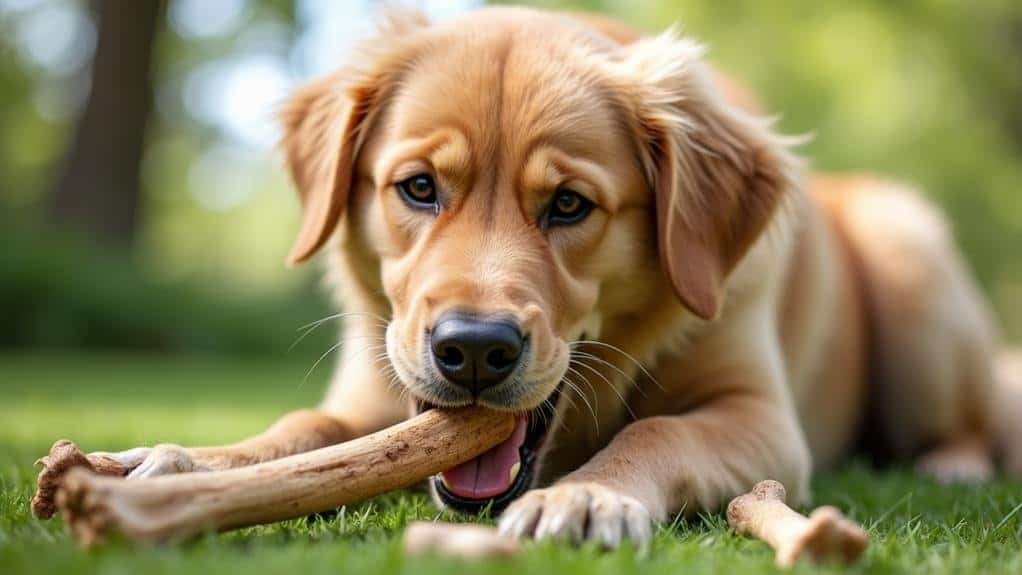Dogs chew bones due to a natural instinct rooted in their ancestral past. This behavior offers numerous benefits, including improved dental health, mental stimulation, and stress relief. Chewing bones can help clean teeth, strengthen jaw muscles, and provide essential nutrients. However, it's not without risks. Potential hazards include dental injuries, choking, and digestive issues. Raw bones are generally safer than cooked ones, which can splinter easily. Always supervise your dog when they're chewing and choose appropriate bones for their size and chewing habits. While bones can be beneficial, there are also safer alternatives available. Understanding the full picture can help you make informed decisions about your dog's chewing habits.
The Ancestral Urge to Chew

Dogs often exhibit a strong, innate desire to chew on bones, a behavior deeply rooted in their evolutionary past. This natural instinct to chew isn't just a random habit; it's a reflection of their ancestral survival instincts.
Your furry friend's fascination with bones can be traced back to their wolf ancestors, who relied on these nutrient-rich morsels during times of food scarcity.
When you see your dog enthusiastically gnawing on a bone, you're witnessing a connection to their wild heritage. This act fulfills more than just a nutritional need; it provides mental stimulation and a sense of satisfaction that taps into their primal urges.
The evolutionary significance of bone chewing extends beyond mere sustenance, as it also helps strengthen your dog's jaw muscles and keeps them physically active.
Dental Health Benefits

Chewing on bones offers significant dental health benefits for your canine companion. When your dog gnaws on a bone, it stimulates saliva production, which helps wash away food particles and bacteria. This natural process promotes overall oral hygiene and reduces the risk of dental diseases.
The abrasive action of chewing bones acts like a natural toothbrush for your dog's teeth. It effectively scrapes away plaque and tartar buildup, keeping their teeth clean and healthy. Regular chewing can lead to healthier gums and teeth, decreasing the likelihood of periodontal disease, which affects many dogs by age three.
Bones provide essential nutrients such as calcium and phosphorus, contributing to stronger teeth and bones. This nutritional boost supports your dog's overall dental health.
Additionally, chewing activities can help alleviate dental-related stress and discomfort, especially in teething puppies, promoting healthier chewing habits.
Mental Stimulation and Stress Relief

How does chewing bones affect a dog's mental state? The natural act of chewing bones provides significant mental stimulation for your canine companion. As your dog engages in this repetitive action, it stimulates brain activity and satisfies their innate instincts. This mental engagement is essential for your dog's overall health and well-being.
Dogs' love for bones goes beyond mere enjoyment; it's a powerful stress reliever. When your dog chews, their brain releases endorphins, promoting feelings of happiness and relaxation. This natural process can help manage anxiety and provide a calming outlet for your pet.
By offering bones as a chew option, you're giving your dog a healthy way to alleviate boredom and reduce the likelihood of destructive behaviors. Chewing bones can keep your dog focused and occupied for extended periods, effectively managing stress and anxiety.
The physical exercise involved in chewing also strengthens jaw muscles, contributing to your dog's overall health. By understanding and supporting your dog's natural inclination to chew bones, you're providing them with a mentally stimulating and stress-reducing activity that enhances their quality of life.
Nutritional Value of Bones
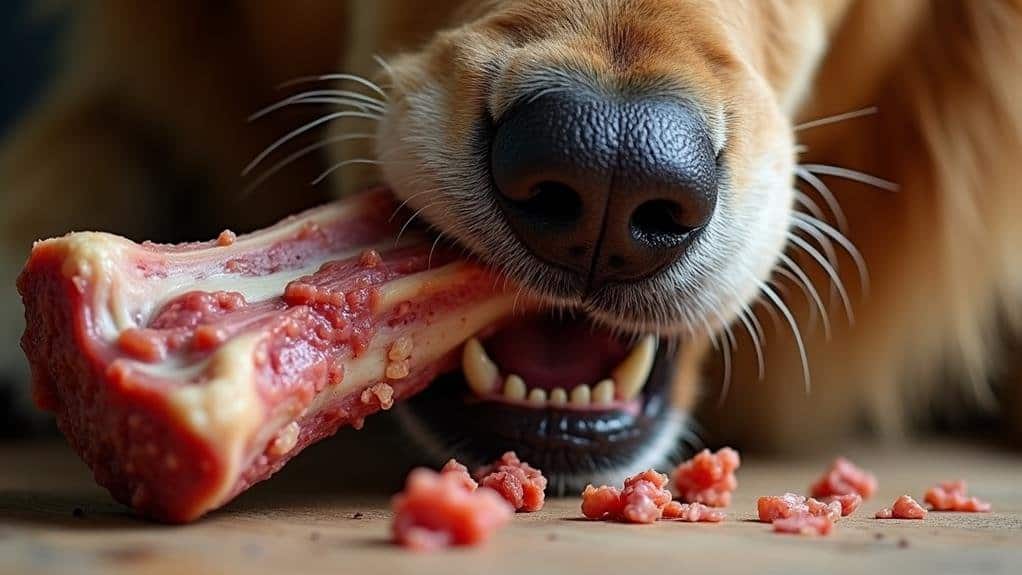
For centuries, bones have been a natural part of canine diets, offering more than just a satisfying chew. They're packed with essential nutrients that contribute to your dog's overall health and well-being.
When your furry friend gnaws on a bone, they're accessing a wealth of nutrients, including calcium and phosphorus, which are critical for maintaining strong bones and teeth.
The marrow inside bones is particularly nutritious, providing a natural source of energy and sustenance for your dog. As they chew, they're extracting important nutrients from this rich center.
Additionally, the act of chewing stimulates saliva production, which aids in digestion and can help reduce plaque buildup on their teeth.
Bones also serve as a source of protein, necessary for muscle growth and maintenance in your natural dog.
By offering properly selected raw bones, you can fulfill your pet's nutritional needs while minimizing risks associated with splintering and choking.
However, it's important to choose appropriate bones for your dog's size and chewing habits to guarantee safety.
Always supervise your dog when they're enjoying a bone to prevent any potential issues.
Potential Risks and Hazards
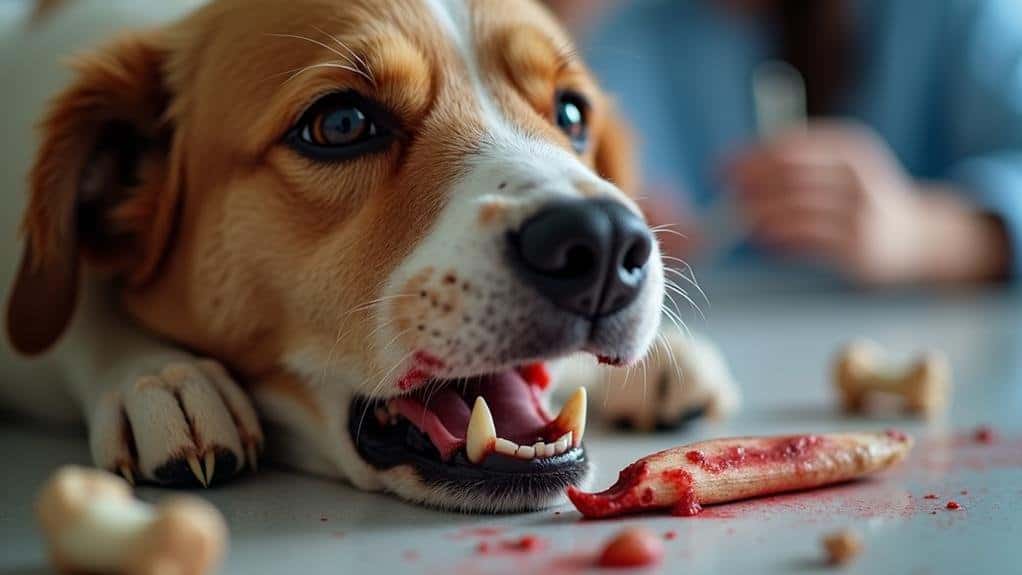
Despite the nutritional benefits, giving your dog bones to chew comes with potential risks and hazards. When your furry friend chews on bones, they might face several dangers that you should be aware of.
One of the primary concerns is the risk of dental injuries. Hard bones, especially weight-bearing ones, can lead to cracked or fractured teeth. This can cause pain and require expensive veterinary treatment.
Additionally, bones might pose a choking hazard or cause intestinal obstructions if your dog swallows splintered pieces. This risk is higher with cooked bones, which are more likely to splinter than raw bones.
Digestive issues are another potential problem. Chewing on bones can result in constipation, diarrhea, or even pancreatitis due to their composition and difficulty to digest. While raw bones are generally safer than cooked ones, they still carry risks.
To minimize these hazards, always supervise your dog when they're chewing on bones. Be prepared to intervene quickly if you notice any signs of distress or choking.
Choosing the Right Bone

Selecting the right bone for your dog is essential to secure their safety and enjoyment. When choosing the right bone, opt for raw bones over cooked ones. Raw bones are less likely to splinter, reducing the risk of choking or internal injuries. Cooked bones, on the other hand, can become brittle and break into sharp pieces, posing a serious hazard to your pet.
Consider your dog's size and chewing habits when selecting a bone. A bone that's too small can be swallowed whole, while one that's too large may be difficult for your dog to handle. Always supervise your dog while they're chewing to guarantee their safety and remove the bone if it becomes small enough to swallow.
If you're concerned about the risks associated with real bones, consider alternatives like synthetic chew toys or vet-approved dental treats. These options can promote dental health without the potential dangers of natural bones.
For personalized recommendations on the best chews for your dog's specific needs, consult with your veterinarian. They can provide guidance based on your dog's age, health, and chewing behavior, securing you make the safest choice for your furry friend.
Raw Vs. Cooked Bones

When it comes to choosing between raw and cooked bones for your dog, the decision can greatly impact your pet's safety and health.
Raw bones are generally considered the safer option, as they're less likely to splinter and cause choking or intestinal obstructions. They also provide vital nutrients like calcium and phosphorus, supporting your dog's overall health.
Cooked bones, on the other hand, pose significant risks. The cooking process makes them brittle, increasing the chances of dental injuries such as cracked or fractured teeth. They're also more likely to break into sharp fragments, which can be dangerous if swallowed.
Raw bones can benefit your dog's dental health by helping to remove plaque and tartar buildup. However, it's important to select appropriately sized bones to prevent choking hazards.
Always supervise your dog when they're chewing on any type of bone, but be especially vigilant with cooked bones due to their higher risk factors.
While raw bones offer more benefits and fewer risks, it's vital to introduce them gradually and monitor your dog's reaction.
If you're unsure about which option is best for your pet, consult your veterinarian for personalized advice.
Supervision and Safety Measures
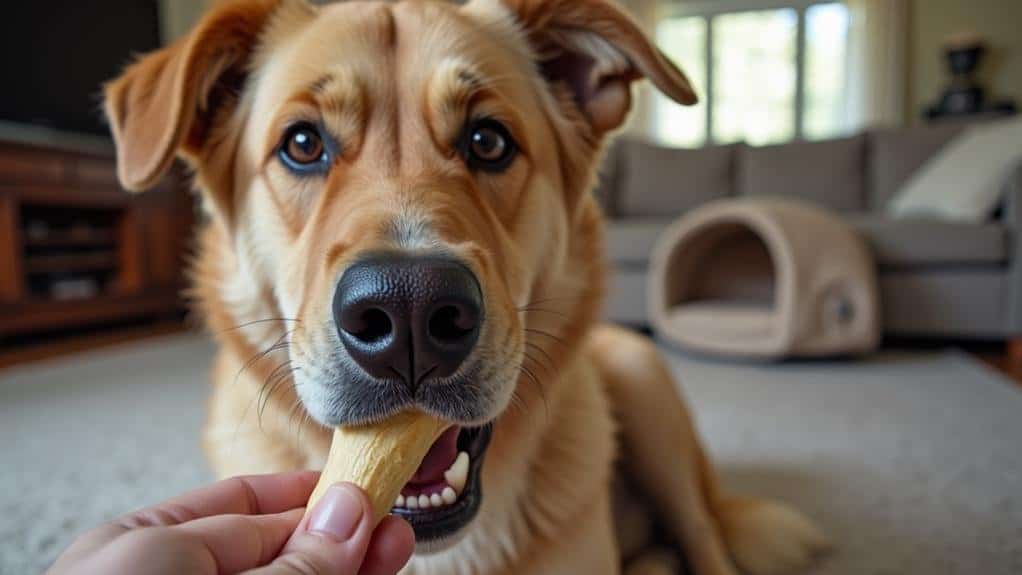
While choosing the right type of bone is important, how you manage your dog's chewing sessions is equally essential.
Supervision is vital when your dog chews on bones to prevent potential hazards. Always keep a close eye on your pet to avoid choking or swallowing large splintered pieces that could cause intestinal blockages.
Select bones that are appropriately sized for your dog to minimize choking risks. A bone that's too small can be swallowed whole, posing a serious threat.
Make sure fresh water is available during chewing sessions to keep your dog hydrated and help flush out any potential splinters.
Regularly inspect bones for signs of wear or splintering, and remove them if they become small enough to be a choking hazard.
While bones can help remove plaque and provide mental stimulation, safety should always be your top priority.
Consult with your veterinarian about safe bone options and appropriate supervision practices tailored to your dog's individual chewing behavior and health history.
They can provide valuable insights based on your pet's specific needs, ensuring a safe and enjoyable chewing experience for your furry friend.
Alternatives to Natural Bones
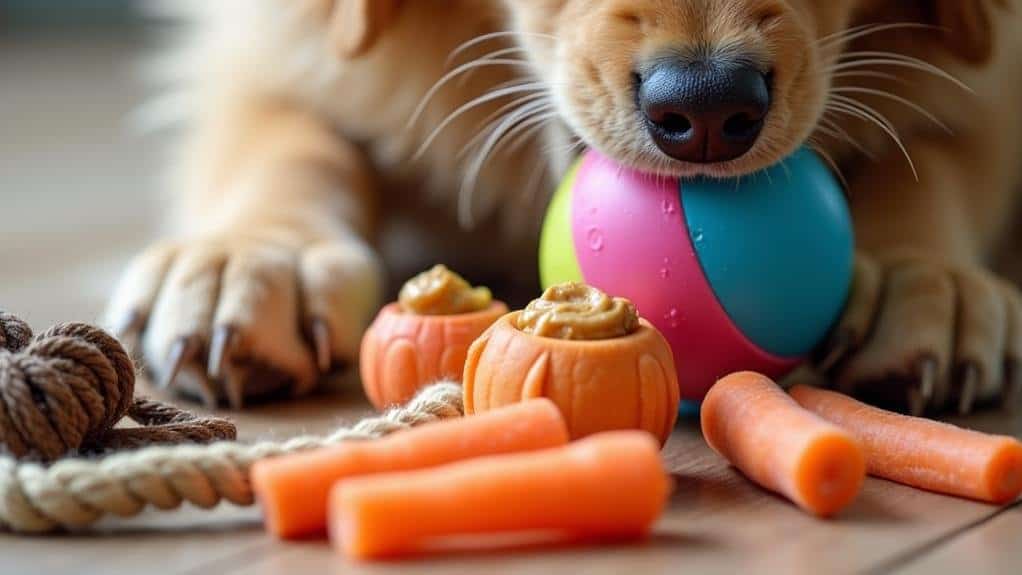
Bone-alternative options abound for dog owners concerned about the risks of natural bones. Bully sticks offer a high-protein, low-fat option that's easily digestible for your canine companion. These dog treats provide a satisfying chew experience without the potential dangers associated with traditional bones.
For a durable and engaging option, consider hard rubber chew toys. You can fill these with treats or peanut butter, providing mental stimulation alongside a safe chewing outlet.
Dental chews are another excellent alternative, specifically designed to promote oral hygiene by reducing plaque and freshening breath.
If you're looking for options closer to natural bones, marrow bones and rawhide chews offer similar nutritional benefits without the same risks. These alternatives can satisfy your dog's chewing instinct while providing essential nutrients.
Regardless of which alternative you choose, always supervise your dog during chewing sessions. This precaution helps prevent choking hazards and guarantees your pet's safety.
Breed-Specific Considerations
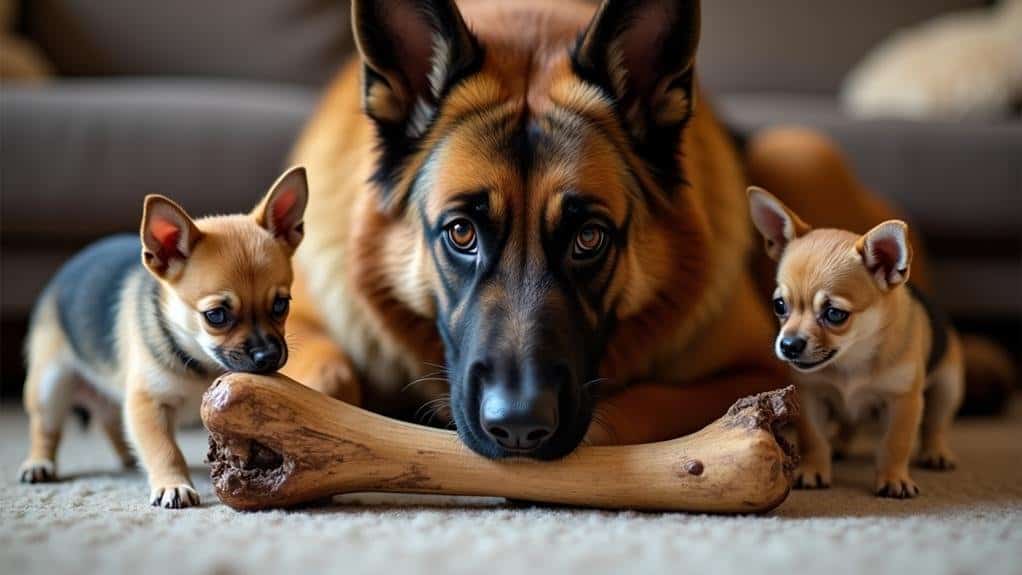
The world of dog breeds offers a diverse array of chewing needs and preferences. When considering why dogs chew bones, it's essential to take into account breed-specific considerations.
Terriers and hounds, for example, have a higher instinctual drive to chew due to their hunting backgrounds. Providing these breeds with appropriate bones can help satisfy their natural urges and channel their energy positively.
For larger breeds like Great Danes and Mastiffs, you'll need to offer bigger bones to prevent choking hazards while still promoting dental health.
On the other hand, breeds prone to dental issues, such as Bulldogs and Pugs, may benefit more from softer chews that cater to their unique dental structures.
High-energy breeds like Border Collies and Australian Shepherds can find mental stimulation and stress relief in longer-lasting chews. These keep them engaged and help prevent destructive behaviors.
Don't forget about puppies! Regardless of breed, they often require appropriate-sized bones to aid with teething. The right texture can provide relief while encouraging healthy chewing habits.
Always supervise your dog when introducing new chews, and consult your veterinarian for breed-specific recommendations to guarantee your furry friend's safety and well-being.
Frequently Asked Questions
Why Do Dogs Need to Chew Bones?
You'll find that dogs need to chew bones to satisfy their natural instincts, improve dental health, and get crucial nutrients. It also keeps them mentally stimulated, reduces stress, and prevents boredom-related behavioral issues. Chewing's a fundamental canine activity.
Why Do Dogs Have an Instinct to Chew?
Your dog's instinct to chew stems from their wild ancestors' survival needs. It's a natural behavior that provides mental stimulation, relieves stress, and promotes dental health. Chewing also strengthens jaw muscles and releases endorphins, making your pup happier.
Do Dogs Benefit From Eating Bones?
Yes, your dog can benefit from eating bones. They'll get essential nutrients, improve dental health, and enjoy mental stimulation. Chewing bones also satisfies their natural instincts, reduces boredom, and promotes overall well-being. However, always supervise bone consumption.
Is Bone Chewing Mentally Stimulating for Dogs?
Yes, bone chewing is mentally stimulating for your dog. It engages their natural instincts, releases endorphins, and provides problem-solving challenges. You'll find it keeps them occupied, reduces stress, and enhances their cognitive function, similar to puzzle toys.
Conclusion
You've learned that your dog's bone-chewing instinct is deeply rooted and offers various benefits. However, it's essential to weigh these against potential risks. Always supervise your pup when they're chewing bones, and consider safer alternatives if you're concerned. Remember, every dog is different, so what works for one might not suit another. By understanding your dog's needs and habits, you'll make informed decisions about incorporating bones into their routine.

